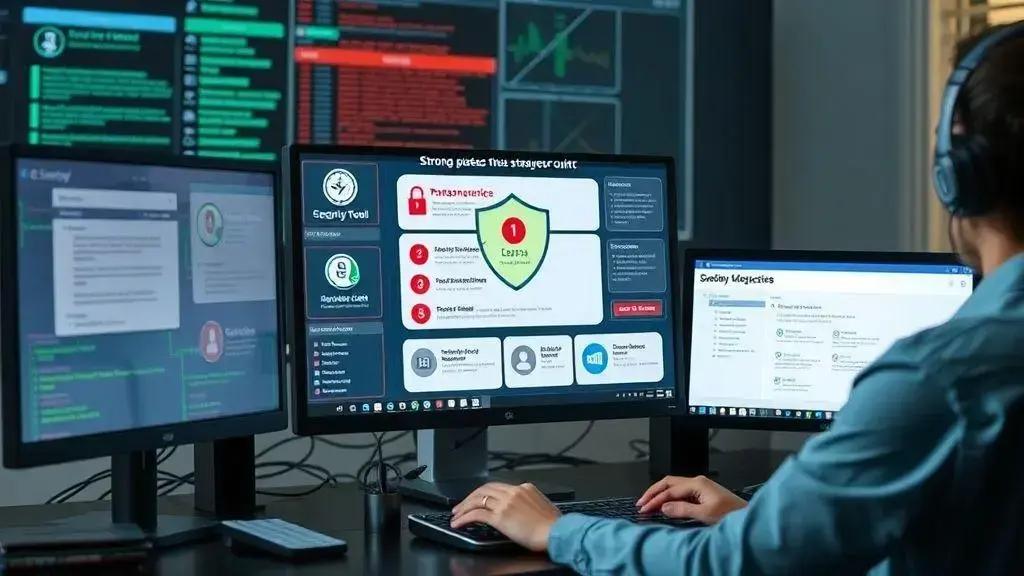Ransomware protection: secure your data today

Ransomware protection involves implementing regular data backups, using strong passwords, and maintaining updated security software to safeguard against attacks that can lock or encrypt your files.
Ransomware protection is something we often overlook until it’s too late. Have you ever wondered how quickly your files could be compromised? Let’s dive into effective ways to secure your data.
Understanding ransomware and its impact
Understanding ransomware is essential in today’s digital landscape. As technology evolves, so do the threats we face. Ransomware is a type of malicious software that can lock you out of your files, demanding payment for access. Understanding how it works is the first step in protecting yourself.
The impact of ransomware attacks can be severe. Not only can they cause significant data loss, but they can also lead to financial strain. Organizations, in particular, face disruptions that can halt operations, resulting in lost revenue. The emotional toll on victims is also significant, leading to stress and anxiety.
Types of ransomware
Ransomware comes in various forms, each with unique methods of attack. Knowing the types can help you be more vigilant in your digital practices.
- Crypto ransomware: This type encrypts your files, making them inaccessible without a decryption key.
- Lockers: Lockers prevent users from accessing their devices entirely until a ransom is paid.
- Scareware: This type uses tactics to frighten users into paying, often displaying fake alerts about malware.
- RaaS (Ransomware as a Service): This is a business model for cybercriminals, allowing them to lease ransomware tools to other criminals.
Each of these types operates differently, but they all have one goal: to extort money from victims. Recognizing the signs of a ransomware attack can help mitigate potential damage. For instance, if your files suddenly become inaccessible or you’re prompted to pay a ransom, it is a clear indicator that you are a victim.
Real-life consequences
The consequences of ransomware attacks can be staggering. Many businesses have faced closure after falling victim. According to recent studies, almost 60% of small companies close within six months of a cyber attack. However, the impact isn’t just financial; it can tarnish a company’s reputation and trust with customers.
In addition to businesses, individuals are equally at risk. Many people have lost precious data, including family photos and important documents, due to ransomware. Preventing such losses requires constant vigilance and effective protection strategies.
Essential strategies for ransomware protection

Essential strategies for ransomware protection are crucial in safeguarding your files and data. As cyber threats increase, understanding the right methods to protect yourself can make a significant difference.
One of the first steps in protecting against ransomware is education. Knowing what ransomware is and how it spreads will help you stay vigilant. Many ransomware attacks occur through phishing emails or malicious downloads. Always be cautious about the links you click and the attachments you open.
Implementing strong security measures
Having strong security measures in place is vital. This includes using reputable antivirus software and enabling automatic updates.
- Keep your software updated: Make sure all applications, especially your operating system and security software, are updated regularly.
- Use strong passwords: Create complex passwords for your accounts and consider using a password manager.
- Enable two-factor authentication: This adds an extra layer of security by requiring a second form of verification.
- Back up your data: Regularly back up your important files to a secure location, ensuring you can restore them if needed.
Implementing these strategies creates a robust defense against ransomware attacks. Regularly training employees about the dangers of ransomware and the best practices to avoid it further enhances your security.
Using cybersecurity tools
Another critical approach is utilizing cybersecurity tools. Many organizations have adopted advanced security solutions that monitor network traffic, detect intrusions, and isolate threats automatically. Firewalls and intrusion detection systems are powerful tools that can identify and block suspicious activities.
Additionally, consider conducting regular security audits and vulnerability assessments. These reviews can identify weaknesses in your system before a cybercriminal exploits them. With comprehensive strategies in place, you can significantly reduce the risk of falling victim to ransomware.
How to recover from a ransomware attack
How to recover from a ransomware attack is a critical topic for anyone who uses digital devices. If you find yourself in this unfortunate situation, it’s important to act swiftly to mitigate damage.
After an attack, the first step is to disconnect your device from the internet. This will help prevent the ransomware from spreading to other devices on your network. While it might seem alarming, knowing what to do next will give you some control over the situation.
Assess the damage
Once you’re offline, assess the damage. Identify which files are affected and determine whether the ransomware has locked or encrypted them. Make a note of any ransom messages that appear, as these can provide insight into the attacker’s tactics.
- Check for backups: If you have a recent backup of your files, you may choose to restore them instead of paying the ransom.
- Document everything: Keeping detailed records of the attack will help in any investigations or insurance claims.
- Notify your contacts: Inform friends, family, or colleagues that your device was compromised, so they can be cautious.
- Report the incident: Contact law enforcement or cybersecurity professionals for assistance.
If backups are available, you can begin the recovery process. Restore your system from a clean backup. Ensure that your software and operating systems are updated to the latest versions before reconnecting to the internet.
Consider professional help
If the situation is severe and you’re unsure how to proceed, consider seeking professional help. Cybersecurity experts can provide guidance and may even successfully decrypt your files without paying the ransom, especially if there are known vulnerabilities in the ransomware.
Additionally, learning from the experience is essential. After recovery, it’s crucial to review and enhance your security measures to prevent future attacks. Regular training on recognizing phishing attempts and best practices can be invaluable for you and your organization.
Importance of regular data backups

The importance of regular data backups cannot be overstated, especially in the face of cyber threats like ransomware. Regular backups ensure that you can restore your critical files, allowing you to recover from unexpected incidents without significant data loss.
Backing up your data is a fundamental practice that everyone should adopt. It acts as an insurance policy for your important information. If ransomware strikes, having recent backups can save you from paying a ransom or losing essential files.
Types of backup solutions
There are various methods to back up your data. Choosing the right solution for your needs is crucial.
- Cloud storage: Solutions like Google Drive or Dropbox offer automatic sync and easy access from any device.
- External hard drives: Physical drives that you can connect to your computer to store large amounts of data securely.
- Network-attached storage (NAS): This provides a centralized storage solution accessible by multiple devices, ideal for organizations.
- Backup software: Programs designed to automate the backup process, reducing the manual workload.
No matter which method you choose, ensure that you perform backups consistently. Establish a schedule that suits you—daily, weekly, or monthly. The more frequent your backups, the less data you risk losing.
Testing your backups
Another critical aspect is testing your backups. It’s not enough to just have copies of your data; you need to ensure they can be restored when needed. Periodically check your backup files to confirm they are intact and functional. This step is vital for verifying that your backup strategy works effectively.
In addition to these strategies, educate yourself about the risks of not backing up. Data loss can occur due to various reasons, including hardware failure, accidental deletion, and cyber attacks. By being proactive with your backups, you can help secure your valuable information and maintain peace of mind.
FAQ – Frequently Asked Questions about Ransomware Protection
What is ransomware?
Ransomware is a type of malicious software that encrypts or locks your files, demanding payment to restore access.
How can I protect myself from ransomware?
You can protect yourself by maintaining regular data backups, using strong passwords, and implementing security software.
What should I do if I fall victim to a ransomware attack?
Immediately disconnect your device from the internet, assess the damage, and consider restoring from backups or seeking professional help.
Why are regular data backups important?
Regular backups ensure that you can recover your data without paying a ransom, minimizing the impact of a ransomware attack.





